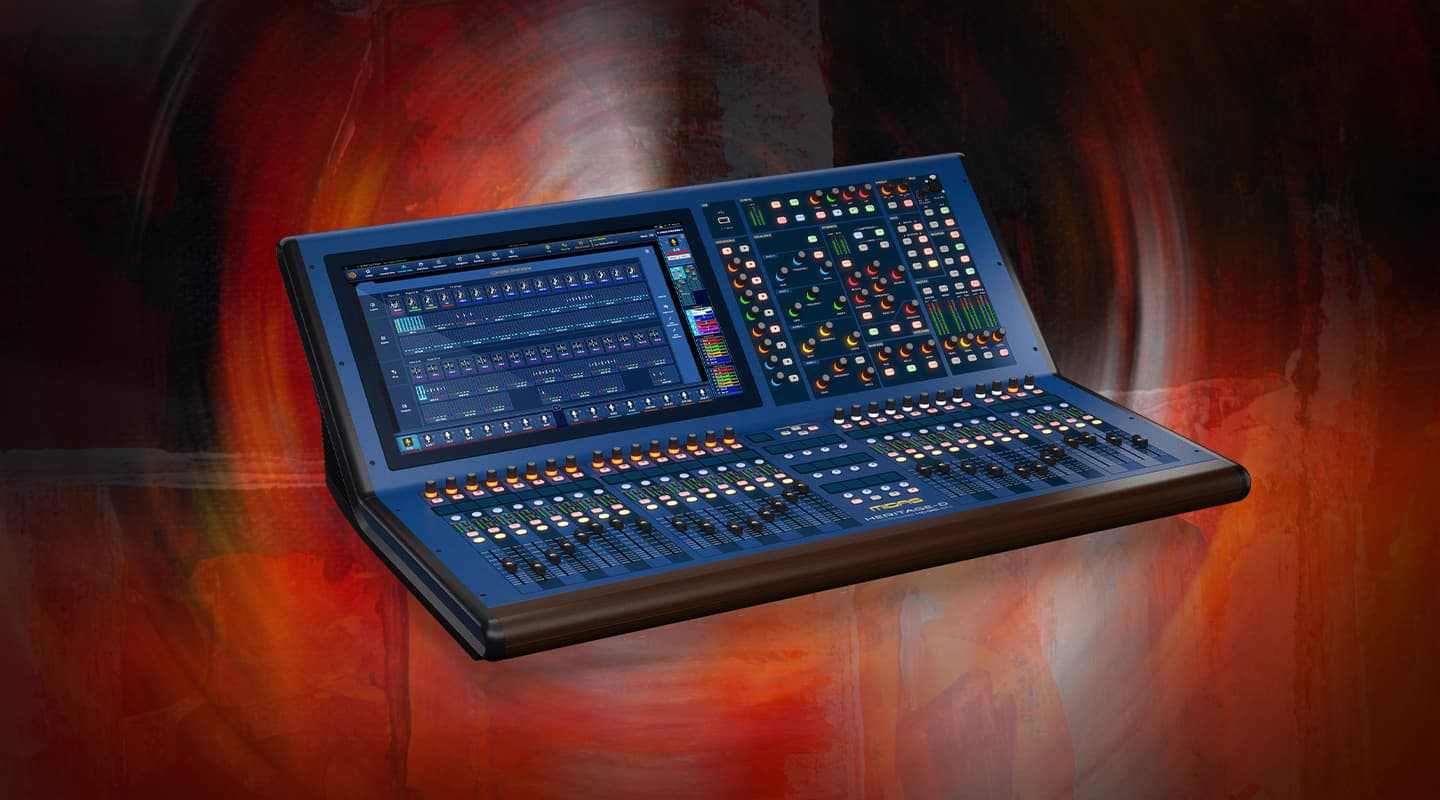
Review: Midas Heritage D
After years of anticipation, Midas’ new flagship live sound digital mixing console hits the market hard.
Review:/ Mark Woods
Nothing stays the same in digital console land. The technology has become widespread even as it matures and, while favourites have emerged, not everything is settled — there’s still room for innovation and new approaches. The Midas Heritage D arrives with expectations raised by naming it after the Midas Heritage 3000 — long regarded as the king of analogue live mixing consoles. Midas enjoyed sustained success with its Pro Series of digital consoles, and continues to enjoy success with its more entry-level M32 Series and its now aiming at regaining the higher ground.
Development of the Midas Heritage D has been allowed to run its course. AudioTechnology had a look at a prototype back in 2019 when the console size, shape, layout and screen were all settled. The last few years have been about testing, collaborating with users and refining the firmware. Now’s the time to spend time with it in the field.
FORM AN OPINION
Midas has got the form right. The console is instantly attractive — it looks great and I found that other audio people were instantly attracted as well. The centrepiece 21-inch LCD multitouch screen is big, well-angled for the user, easy to reach and responsive. Most operations can be controlled from the screen (including faders on screen) but it doesn’t totally dominate the console. The section to the right of the screen has nicely-lit, touch-sensitive knobs and buttons that fall easily to hand when you reach for them and trigger relevant setting displays on the screen when you touch them. Tapping the screen is great for instant big changes but real knobs can be less distracting than dragging on the screen for nuanced adjustments.
FOLLOWING FUNCTION
The Heritage D is a live show console whose form follows function. It’s not exactly penguin-portable but it doesn’t take up too many seats either, and it’s a commanding, luxurious space to work when you’re standing behind it. The 28 x 100mm motorised fader layout is the right amount for a live digital console, in my opinion — it minimises layer surfing and it gives the console a somewhat traditional feel by being able to stripe 24 input channels across the board quickly.
The rear panel has 8 x analogue XLR ins and outs, 2 x Ultranet ports, 4 x direct AES50 sockets and a dual network bridge format converter. Dual HyperMac snake sockets have optical and copper connections. The CM1 slots can accommodate MADI (64 channels) and Dante (64 channels). BNC wordclock I/O, AES3 sync I/O, 2 x HDMI monitor outs are available for possibly dual-operator mode and a USB socket. Dual-redundant power supplies are fed from 2 x IEC mains sockets.
Under the surface the processing is powerful and the raw numbers are state-of-the-art: Graviton Mk2 engine, 18 SHARC audio processors, 5 FGPAs, including a 64 summing engine, and 2 GPU co-processors controlling 144 Flexi channels into 96 Flexi outputs, 24 matrices plus the stereo and mono bus.
There are a number of stageboxes to choose from, all in the current Midas catalogue: the Midas DL151, the DL153, and the chunkier DL251, which offer various combinations of ins and outs.
MORE INFO
Midas Heritage D
Live Sound Digital Mixing Console
PRICE
From ~A$56,000
CONTACT
Australis Music
(02) 9698 4444 or australismusic.com.au
PROS
Excellent sound
Lots of processing power
Innovative features
Ideal size format for most applications
Superior GUI & touchscreen
CONS
Sometimes idiosyncratic
Customisation can be daunting
SUMMARY
The Heritage D is a great-sounding and ambitious live sound digital mixing console. Rather than simply trading on the Midas name, it is pushing innovation and not skimping on the processing power. Whether it gains widespread rider-friendly acceptance is down to other market forces: Heritage D will easily fit any audio production requirement in any mid to large size venue, house of worship, theatre or rental company.
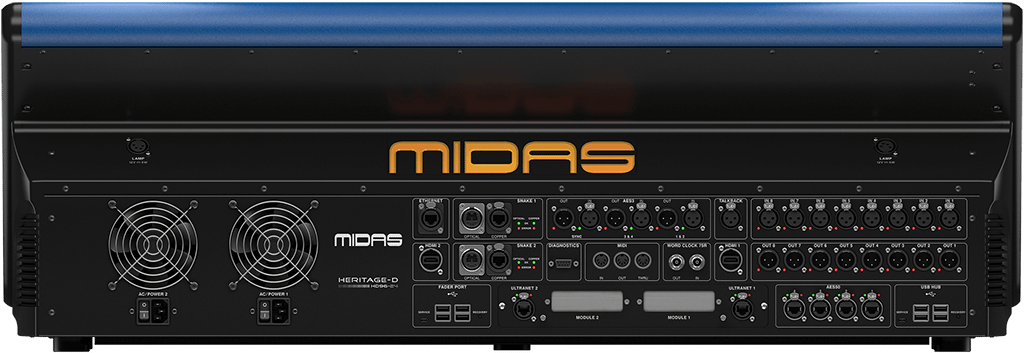
SOUND IS EVERYTHING
Midas has prioritised sound quality and it starts with its renowned preamps (I’ll talk about those some more later in the review). After conversion, there’s 64-bit floating point processing of 24-bit/96k audio throughout with no compromise in performance or channel count. Extensive delay compensation and phase alignment on all outputs combine to minimise comb-filtering effects. I/O latency is quoted as 1.34ms.
Internet connectivity is a feature of the Midas Heritage D. Users can create a Midas Cloud account on the Midas website. Show files can be saved to the cloud so as to be retrieved as required rather than relying on a USB drive. User presets can be stored and firmware updates can be done online. If there is no internet available the console works offline, local users can be set up and their work stored on the console.
ACROSS THE BOARD
Once connected, tabs across the top of the screen get you most places you need to go. The Patching tab is intuitive for new users but the full depth of functionality will take time to explore.
Once patched, the Navigation tab offers preset and customisable navigation layouts based around five modes related to how the user wants to operate – HD96 and Pro series modes are Midas landscapes and there’s also VCA, Theatre and Monitor modes. Dedicated buttons between the fader banks can be used to switch between modes during the show.
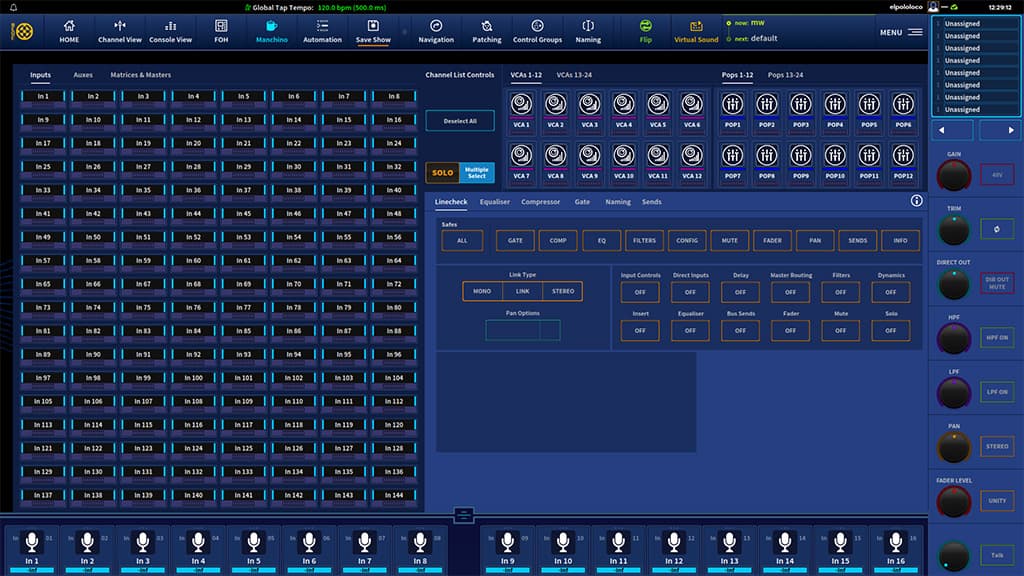
LEARNING CURVE
To get the most out of the console will require some learning, they all do, but perhaps especially here because the Heritage D offers features you didn’t even know you needed. A good example is the unique Manchino page. No one seems to like the name but that doesn’t matter because it’s a powerful copy/paste/group manipulator that can patch or apply changes to multiple channels simultaneously. There’s no obvious precedents for it, and it takes some exploring to realise its full potential, but it’s an efficient way of applying common attributes to multiple input channels when setting up. There’d be uses for temporary ganging of channels with absolute or relative level controls, and Manchino offers some clever ways of dealing with multiple monitor sends quickly during soundcheck, for example.
You didn’t know you needed Tags either. The Heritage D uses metadata to tag common functions or processes and lets you use the tags to select channels. All channels with a compressor, for instance, can be selected, they stripe across the console for easy access and give you a useful overview of all the channels being compressed… it can change the way you look at the channel dynamics seeing them all together. A Clipped Channels tag selects all channels that have overloaded (and offers the chance to collectively drop their input gains). Selecting channels tagged as Patched reassures the paranoid operator just wanting to be sure.
JOIN THE GROUP
Then there’s groups and groups of groups. The 24 VCAs and 24 Pop groups can be organised from Manchino or the Control Groups tabs. Buttons in the centre of the fader bank let you get to your preferred groups quickly and remove the need for anonymous layers. Between the VCAs, Pop Groups, Manchino, Tags, Auxs and assignable buttons/knobs there are many ways to get to and control the channels.
The Flexi Aux setup allows auxes to be sent to auxes, making handy sub-groups for FOH and/or IEM mixes as well as regular aux functions like foldback from FOH. The Shout Mixer operates separately — the 12 Mute groups are available as well as 12 Talk groups for shout mixes.
WARM & NATURAL
Functionality doesn’t mean much if it doesn’t sound good, and I found the Heritage D has a solid and effortless sound quality, quite warm and natural overall, and as good as I’ve heard from a computer with faders. The reaction of several experienced mixing professionals hearing the Heritage D for the first time confirmed my impressions — they all liked the sound.
Like painting a room, most of the work is in the preparation. Setting up a show, patching the stageboxes, and getting sound is not hard and the console gives you hints where it’s not right. The naming page deserves mention for its ease of use — unlike some budget consoles where tape and texta is still easier. Hi-res pixels (240×240) deliver sharp lettering on the scribblers too. This is a great console for those with less than perfect eyesight.
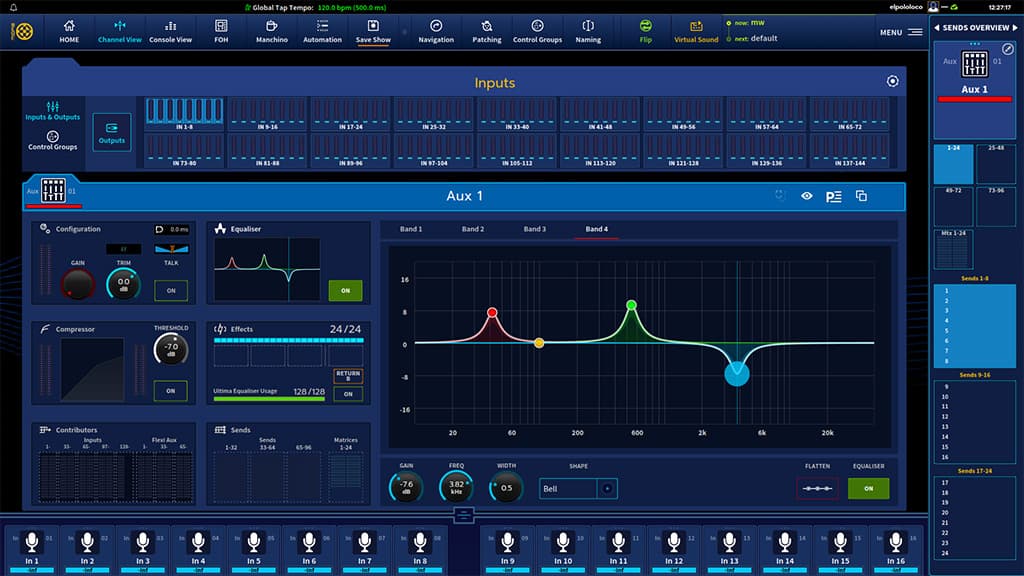
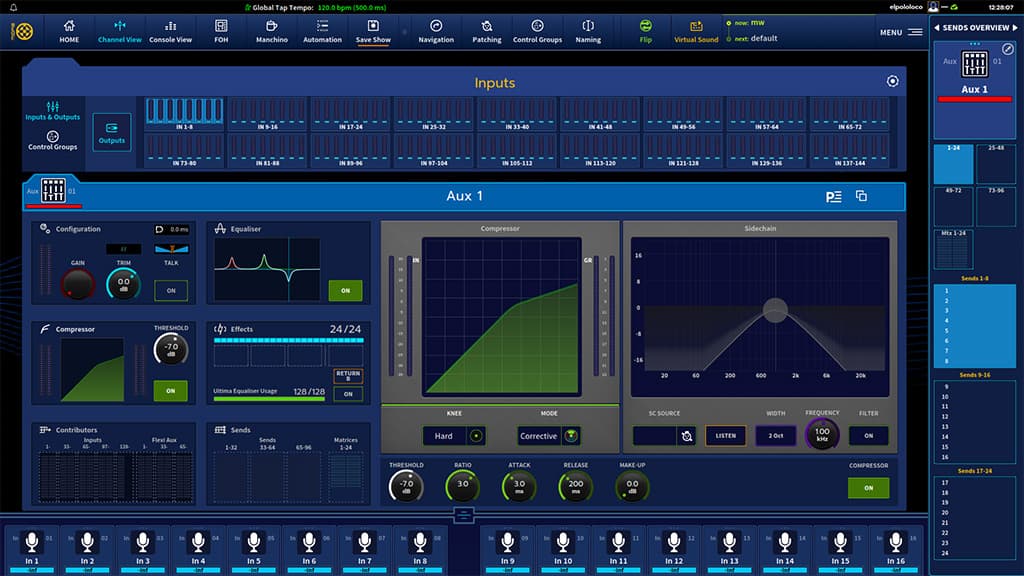
MIXING IT WITH HD96
Mixing a show on the Heritage D is certainly fun. At first it’s all about the screen and the larger-than-life GUI that rewards interactions and offers good control of most functions. It’s convinced me that one big touchscreen is better than multiple screens, and much better than the little screens that are hard to see. It can be very bright too; bright enough to work outdoors in the full Australian sun.
Tearing my eyes away from the interesting functions and options on the screen long enough to listen to the band was a challenge at first but once the channel processing and grouping is in place, you can mix on the faders and knobs without using the screen much at all — I find it less distracting. Or you can fully embrace it and mix on the screen — the virtual faders are much better than a tablet or phone, you can use up to 10 simultaneously, and the screen responds well to pinch and swipe gestures. I sense a trend to move past faders and knobs and do it all from the screen, it would be cheaper to make them, but it’s a different feel working the screen, better suited to occasional changes rather than riding levels.
The size and layout of the Heritage D is great for flowing with the music, everything is right in front of you and nothing feels shoe-horned in. An advantage of the big screen is you can get so much content on view and it’s all clear and easy to interrogate. It’s a similar story for the physical controls: there’s space between knobs, and if you think of something to change, the controls won’t be far away. A vertical section on the right side of the screen gives a handy contextual snapshot of either Channel view or One Shot Pot (level and delay trims) or a display of the Sends Overview and Sends Details. These work with a horizontal row of eight knobs next to the screen that control the send levels. They’re multi-functional but do a great job of driving foldback sends. Fader Flip is another way.
The Heritage D doesn’t record directly onto the console but there’s patching to 144 tape returns to facilitate virtual soundchecks. An RTA is mentioned in the DSP configuration but access to it wasn’t obvious on the surface or screen.
“”
the Heritage D has a solid and effortless sound quality, quite warm and natural
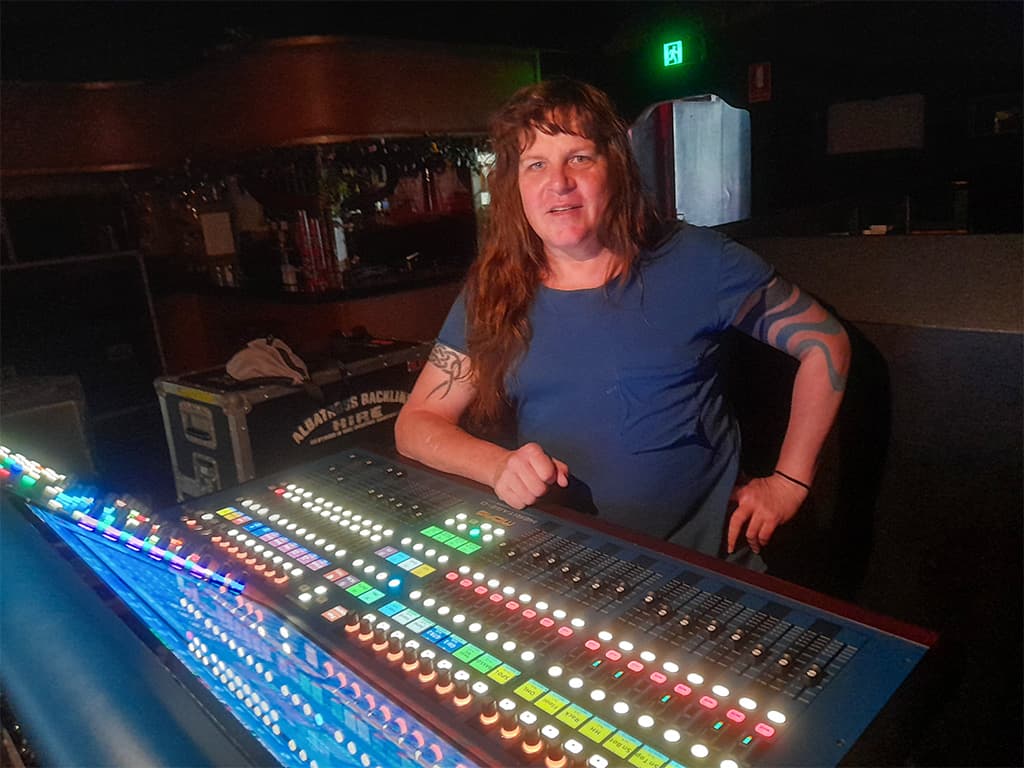
IN SITU: CASEY RICE
I had the Heritage D set up at the Theatre Royal for a few weeks and had a lot of interest from local and visiting sound mixers — they all knew it existed and were keen to have a look and a listen. Castlemaine’s own Casey Rice (Sigur Ros, Tortoise) had just returned from a world tour with Stereolab, and he’d seen and used a Heritage D in the US and was particularly impressed by the sound quality. He thought the firmware and displays were in some ways different to the current version but his showfile on a USB stick opened up without bother.
“Stereolab travelled using house consoles everywhere. It was my first longer tour using digital mixers for FOH and I found it much much friendlier than other models I encountered along the way.
“I used a Heritage D for front of house at The Observatory in San Diego with Stereolab. They also were also using one for monitors. The sound of the console is great, the EQ in particular delivers what you expect applying it and sounds markedly better than other digital consoles to my ears.
“The touchscreen is a real winner on this model — no flaky touchscreen means not tapping something several times to get it to work. The way the screen is configurable makes sense to me. The floating controls are a great idea and I felt much more at ease first time around on this than most any other digital console.
“The internet connectivity is an interesting feature: the software revision on the San Diego model was just using local accounts. I don’t see a great need for a Midas cloud for my show files. I suppose if you are a venue with multiple technicians it may make things a bit more tidy but personally I just see it as another possible point of failure. Improvements? It would be nice to be able to import Pro2 files, even with a utility app if necessary.”
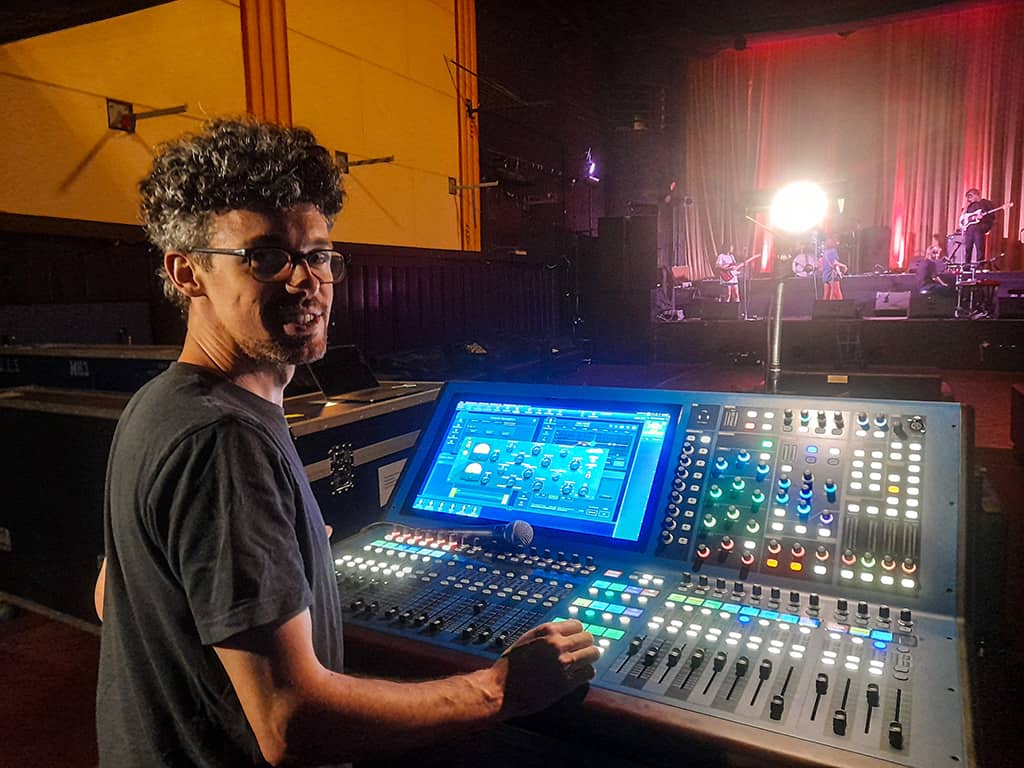
MORE INPUTS: LOUIS CORNELL
Visiting mix engineer Louis Cornell is one of my favourites and part of the new breed of operators that were brought up on digital consoles and approach them with confidence. He had a look at the online editor before the show so he wasn’t flying totally blind but he was all over it at soundcheck and made full use of the patching/grouping/processing/FX power on hand even though he had never seen one in the flesh before. He was mixing Stella Donnelly and got a great finely-controlled and polished sound on the night.
“I think it’s a great console, and I’d be interested to see the uptake in the live community.
“The sound of the console is excellent — very Midas… every change I made was noticeable, pleasing and musical. The onboard plugins seem like a great deal of fun but with such a short show I couldn’t explore them all. I’d love to fiddle around further with everything on board and get an idea of what comps, EQs and other plugins I might want to use in certain circumstances.
“The physical controls are also good: a mixture of the old Pro series layout, the M series layout and some clever updates. The coloured encoders make navigation fairly quick to get up to speed with.
“The GUI is unique and took some warming up to but with a few button presses and guesses I was able to figure out where most things were. I’m sure with a house tech present to teach me the best ways, or some training, I’d be flying around the board in no time.
“”
it’s a commanding, luxurious space to work when you’re standing behind it
“The flexibility of building layouts is good, though, again, it was a little confusing to see why they had so many named views like FOH, Monitor, Theater etc. I assume there’s a rationale behind it but it didn’t help me. I couldn’t see how to set the macro buttons between the fader banks, so I used the ones in the default file and they served me well. Doing the basics was pretty easy to figure out, all the intricate stuff would take some learning and time on the board, for sure.
“To be honest, by default, I don’t like the internet connectivity as a function. The internet can be full of danger and connecting a desk to the internet seems like it could be opening the console up to hackers or malware, I’m sure Midas and its consoles are a small target but what if!? That said, I did manage to get my file off the cloud and load it successfully, so that was nice.
“Groups are easy enough to make. I did some homework and read about Flexi groups — I’m glad I did. Being able to bus from a group to another group before hitting the master is a real gem. Putting the groups where I wanted was another issue, having unrequired aux buses everywhere looked messy and I didn’t love it, but I’m sure I’d get used to it or there’s a way of cleaning that up.
“I used Manchino offline to set a bunch of groups and turn on EQs/comps etc. It seems like a good way to quickly do thing en masse, but also feels like you could dig yourself some holes too. I didn’t use it live on the day, it seems more like a setup function. I didn’t use the Tags at all. I’d seen the name but didn’t know what they did and between the Pop groups, Auxes and VCAs etc, it seemed like I had enough ways to recall channels as needed.
“What I used of the effects seemed nice, especially the delay, and the Distressor copy was lovely, as was the Ocean (Lake) EQ. There’s a good selection of things: the 670 and 1176 were all good to use. I’d like to spend more time with it. It seems like the number of ways you can customise and tailor this console to your needs is deep and amazing. Though a little daunting.”
MIDAS FOREVER?
While touring the UK/Europe in the 1980s, an analogue Midas Pro40 paired with Martin Audio speakers was the preferred system. Those old Midas consoles were simple but had plenty of headroom, great EQ and a strong fat sound. The Heritage D is deep and powerful and would be a fun board to tour now, there’s plenty to explore in the idle hours during rehearsal or soundcheck.
The Midas Heritage D is a big picture live console for these times. It condenses much of what’s been learnt from the last 20 years and presents it on a modern platform with huge processing power that supports 96kHz resolution, a big channel count and contemporary connectivity. It pushes the future with cloud support, AI source recognition and clever use of metadata.
Midas sees the workflow as a culmination of the H3K and Pro Series consoles the Heritage D replaces, and one of its strengths is helping users set it up the way they want to mix. Midas’ reputation for high sound quality will be maintained and I see the Heritage D as having a long life with firmware updates from time to time. I’ll be interested to see if it becomes rider friendly or an esoteric exotic. Either way it’s a technically impressive and thoroughly modern console that will win friends. Ideal for touring, venues, churches or festivals.


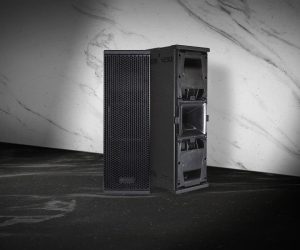









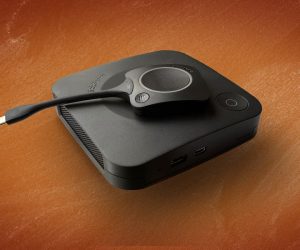


RESPONSES